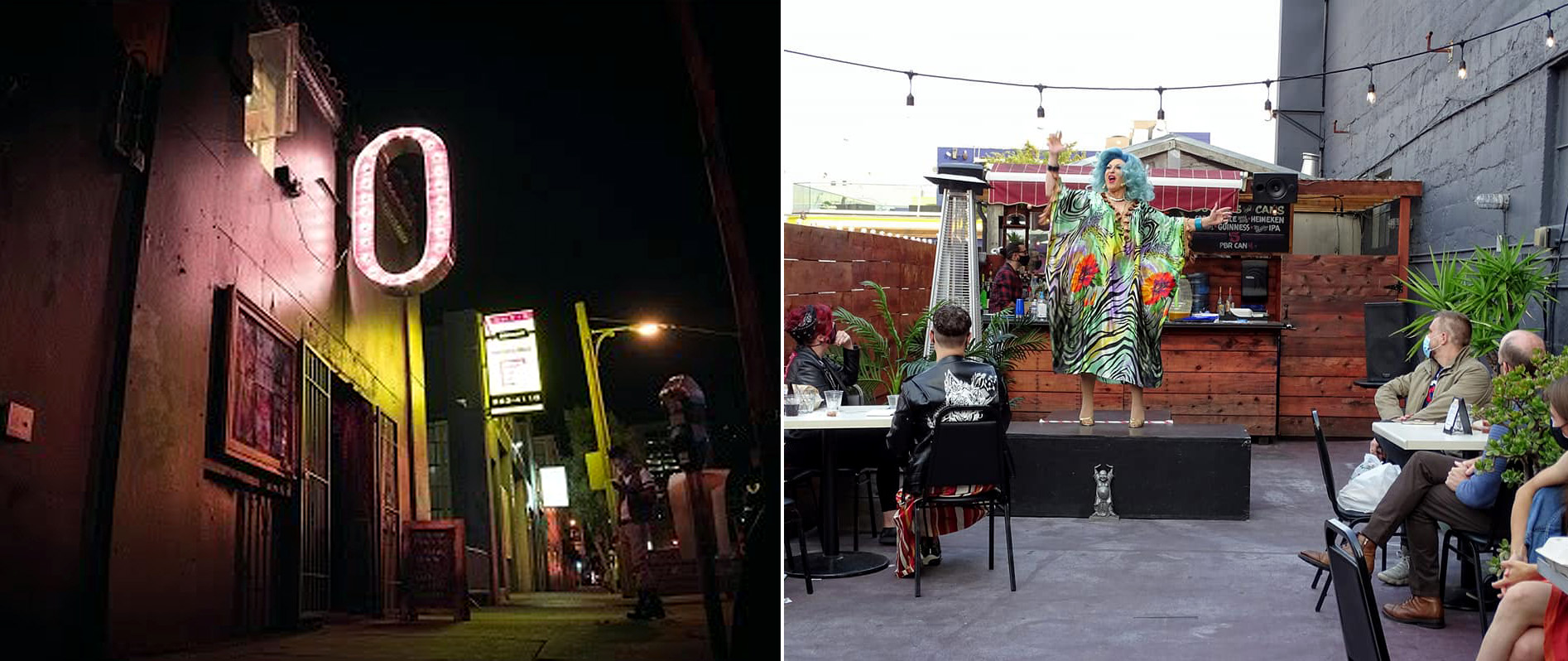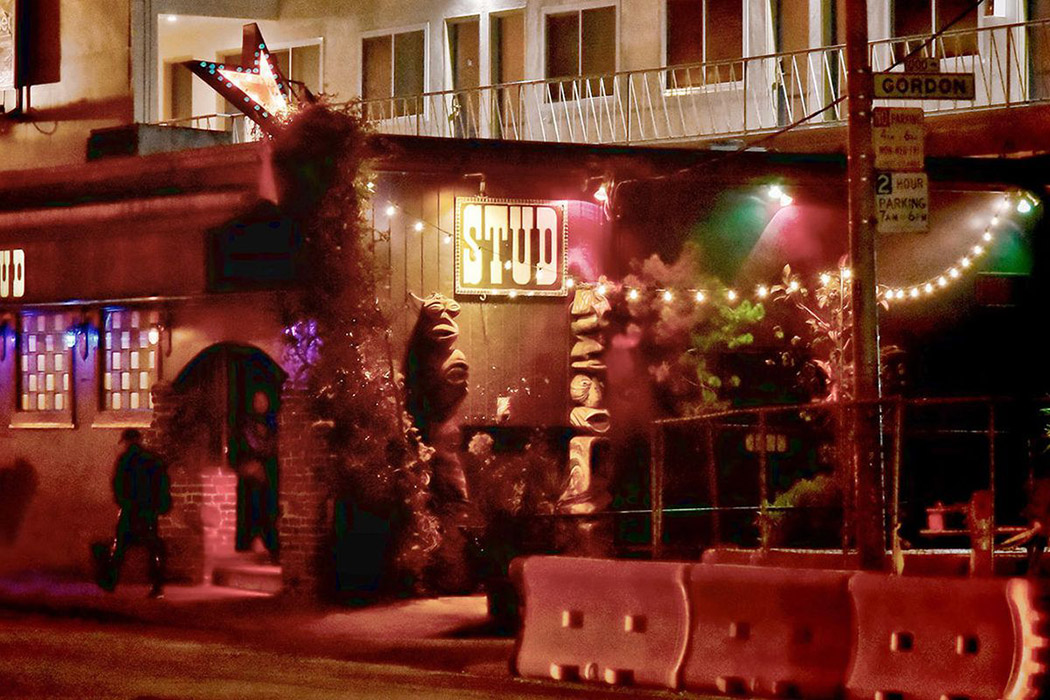By Will Seagers
Today's rather odd blog title indicates a duality in our visit of San Francisco's bygone days: SoMa/Folsom and The Haight. Partially because of one man - Sanford Kellman - who had legendary establishments in both sections of town.
It is hard to leave the SoMa/Folsom area without paying tribute to one of the most iconic bars on Folsom - The Bolt. Known to the gay community as a major leather bar, it drew visitors from far and wide. On any given night one could see the cream of the crop in terms of a "Man's Man" in this medium-sized venue. Quite frankly, I don't remember what the inside of the bar resembled because I was always looking at the incredible men it attracted! As a result, lots of contests and themed events took place there. I do remember iconic construction hardware and, in particular, construction hats as part of its theme. It was one of the first bars to incorporate chain-link fence as partitions in parts of the bar. This was used countless times in other bars (and films) due to the sexual undertones.

Chain-link fence in Chicago's Bijou Theater's dungeon room
And, I can't leave this part of SoMa/Folsom history without mentioning "The Eagle!" Again we find ourselves in the "thick" of leather country! It had an indoor and vast outside patio. With a high fence as its perimeter, the outside patio played host to Sunday Beer Bashes where lots of its aforementioned leather crowd took advantage and LOTS of skin was exposed. Perhaps, The Eagle was most famous for its Leather Contests. Runways were constructed out on the patio where Leather Daddies and the like strutted their stuff to win some highly coveted titles. Yes! The Eagle deserves Icon status, as well!

SF Eagle ad
Last but not least on our SoMa/Folsom bar tour is The Powerhouse, another legendary leather venue. Located at 1347 Folsom, across the street from the infamous Dore Alley, this hot spot hosted lots of hunky, bare-chested men. Also, it was known for the Bare Chest Calendar Contests that were held monthly. One's tour of the SoMa/Folsom area was not complete without a stop over at this location.

Oh, that infamous alley! (L) & The friendly inmates at The Powerhouse (R)
Back to Sanford Kellman. In 1977, he ventured into the Haight/Ashbury area (1748 Haight St. to be exact) to open one of the most successful dance clubs in San Francisco's gay history - The I Beam! Mr. Kellman carried his construction item theme to a grand level in this club. Hung above the spacious hardwood dance floor was a replica of an actual I Beam wrapped in silver mylar. A great sound system was created for the space by noted audio specialist Randy Schiller, who also provided systems for Castro bars such as The Badlands (where yours truly played for four years). Randy also provided great sound for lots of parties at large around the city such as at The Galleria.
Now, more about The I Beam. Upon entering, one had to ascend a major staircase, as the club itself was on the second floor. (Or was it the third? Lol.) After passing the coat check you encountered a massive game room filled with pool tables and pinball machines. The long bar was to the right, flanking the huge dance floor. Entertainment was brought to you by great DJs like Timmy Rivers, Steve Fabus and Michael Garrett, just to name a few. I remember many times when it got so hot in there that you would skid on the sweat on the dance floor! No joke! Leaving the club could be a bit of a challenge. With the popularity of Quaaludes and that staircase you had to navigate a second time on your way out, many revelers took a tumble! All kidding aside, this club and Mr. Kellman definitely left their mark on the city!

I Beam flyer
Located at 1840 Haight St., at the end of Haight and across from Golden Gate Park, was Bones. This bar preceded The I Beam by a few years and provided the neighborhood and the community with many DJ talents. Coming to mind were the two DJs most frequently behind "The Wheels of Steel" (once again) - Timmy Rivers and Michael Lee. A two-man team known to most as just Jack and Jerry were its owners. Although Bones was not as large as The I Beam, it sported a very sophisticated sound system using Klipsch Corner Horns and top end electronics. (Systems like this put Bones in a league like David Mancuso's LOFT of NYC, famed for its sound from way back at the very beginning of dance clubs.) Like the I Beam, Bones would get hellishly hot and the dancers would usually leave the club drenched! Because of its size and drawing power, it was inevitable that Bones would be eclipsed by the I Beam and close.

Klipsch Corner Horns
So, praise be given to those who invested in our bar-going and nightclub pleasures from one end of San Francisco to another! A good time was had by all!
Bio of Will Seagers:
Will Seagers (also credited as Matt Harper), within his multifaceted careers and participation in numerous gay communities across the country in the '70s and '80s and beyond, worked as a print model, film performer, and DJ, just to name a few. He made iconic appearances in releases from Falcon, Hand in Hand, Joe Gage, Target (Bullet), J. Brian, Steve Scott, and more, including in lead roles in major classics like Gage's L.A. Tool & Die (1979) and Scott's Wanted (1980). He brought strong screen presence and exceptional acting to his roles and was scene partners with many fellow legends of classic porn.
George Ferren, a close friend of Will's frequently mentioned in his blogs, was a major figure in the San Francisco music scene in the '70s/'80s. His current music is available for your pleasure on Soundcloud: BY GEORGE

You can read Will Seagers' previous blogs for Bijou here:
Welcome Matt/Will
What's For Dessert?
On and Off the Set of L.A. Tool & Die
Wanted, Weekend Lockup and Weekends in Hermosa Beach
Honeymoon in the Palms
Birds of a Feather
The Stereo Maven of Castro Street
The Pass Around Boy
The Ecstasy and the Agony
Fitness and Fantasy: The Early Gyms
Chasing the Boys and Chasing the Sun: My Story of Sun Worship and Where It Got Me
Becoming Invisible
The Reverse Story of Dorian Gray
Pin Money
One Organ Leads to Another! Part 1
The Wheels of Steel
Feast and Famine: The 1970s to the 1980s
An Alphabet Soup of Powders and Pills
Merry Christmas (and Getting Re-Organized)
Now and Then
DEEP INSIDE THE CASTRO: The Badlands
DEEP INSIDE THE CASTRO: Moby Dick Bar
DEEP INSIDE THE CASTRO: "Just Another Stroll Down the Castro!"
Diving Into SoMa/Folsom: Hamburger Mary's
Diving Into SoMa/Folsom: Long Live the Stud!
Diving Into SoMa/Folsom: Club Life..."Hit me with your Rhythm Stick!”
























 Join our Email List
Join our Email List Like Us on Facebook
Like Us on Facebook Instagram
Instagram Youtube
Youtube Follow Us on Twitter
Follow Us on Twitter Follow us on Pinterest
Follow us on Pinterest